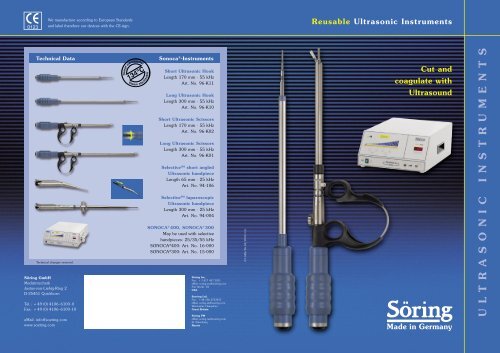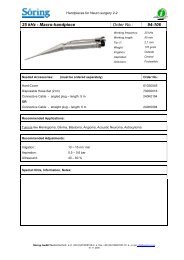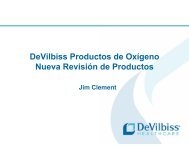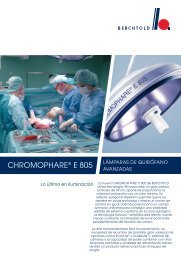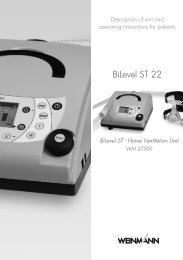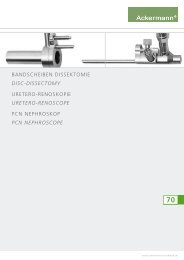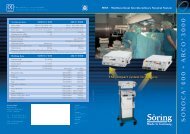Ultrasonic Instruments
Ultrasonic Instruments
Ultrasonic Instruments
You also want an ePaper? Increase the reach of your titles
YUMPU automatically turns print PDFs into web optimized ePapers that Google loves.
We manufacture according to European Standards<br />
and label therefore our devices with the CE-sign.<br />
Reusable <strong>Ultrasonic</strong> <strong>Instruments</strong><br />
Technical Data<br />
Technical changes reserved.<br />
Söring GmbH<br />
Medizintechnik<br />
Justus-von-Liebig-Ring 2<br />
D-25451 Quickborn<br />
Tel.: + 49 (0) 4106-6100-0<br />
Fax: + 49 (0) 4106-6100-10<br />
eMail: info@soering.com<br />
www.soering.com<br />
Sonoca ® -<strong>Instruments</strong><br />
Short <strong>Ultrasonic</strong> Hook<br />
Length 170 mm · 55 kHz<br />
Art. No. 96-K11<br />
Long <strong>Ultrasonic</strong> Hook<br />
Length 300 mm · 55 kHz<br />
Art. No. 96-K10<br />
Short <strong>Ultrasonic</strong> Scissors<br />
Length 170 mm · 55 kHz<br />
Art. No. 96-K02<br />
Long <strong>Ultrasonic</strong> Scissors<br />
Length 300 mm · 55 kHz<br />
Art. No. 96-K01<br />
Selective SM short angled<br />
<strong>Ultrasonic</strong> handpiece<br />
Length 65 mm · 25 kHz<br />
Art. No. 94-106<br />
Selective SM laparoscopic<br />
<strong>Ultrasonic</strong> handpiece<br />
Length 300 mm · 25 kHz<br />
Art. No. 94-004<br />
SONOCA ® 400, SONOCA ® 300<br />
May be used with selective<br />
handpieces: 25/35/55 kHz<br />
SONOCA ® 400: Art. No. 16-000<br />
SONOCA ® 300: Art. No. 15-000<br />
Söring Inc.<br />
Fax: + 1 817 457 2201<br />
eMail: soring-usa@soering.com<br />
Fort Worth, TX<br />
USA<br />
Soering Ltd.<br />
Fax: + 44 196 2733917<br />
eMail: soring-uk@soering.com<br />
Winchester, Hampshire<br />
Great Britain<br />
Söring PM<br />
eMail: soring-rus@soering.com<br />
St. Petersburg<br />
Russia<br />
03 - 888/ 06-04/ 2000 / CG<br />
Cut and<br />
coagulate with<br />
Ultrasound<br />
U L T R A S O N I C I N S T R U M E N T S
Physical-technical and medical basics of <strong>Ultrasonic</strong> Surgery<br />
Indications with<br />
Sonoca ® -<strong>Ultrasonic</strong>-<br />
<strong>Instruments</strong><br />
Although the indications listed below<br />
do not cover the range of potential<br />
applications of the Sonoca ® ultrasonic<br />
instruments, they do show the<br />
potential applications of ultrasonic<br />
instruments are greatly extended by<br />
surgeons and natural scientists in cooperation<br />
with Söring:<br />
Surgery<br />
• Cholecystectomy<br />
• Laparoscopic sigma resection<br />
• Fundoplication<br />
• Adhesiolysis<br />
• Laparoscopic rectum resection<br />
• Hernia<br />
• Partial liver resection<br />
• Hemorrhoidical tissue<br />
Gynaecology<br />
• Tumour resection<br />
• Adhesiolysis<br />
• Laparoscopic ovarectomy<br />
• Myoma extirpation<br />
• Cyst extirpation<br />
• Myoma/polyp resection<br />
• Hysteroectomy<br />
Urology<br />
• Prostataectomy<br />
<strong>Ultrasonic</strong>-Hook Application<br />
Introduction<br />
Via a piezo ceramic system in the handpiece, the microprocessor-controlled<br />
generator converts electric energy into mechanic energy.<br />
The blades located on the distal instrument tip perform an axial oscillation<br />
at frequency of 55 kHz. The deflection reaches ranges between 10<br />
and 100 micrometers. Power adjustment to the ultrasound instruments<br />
is available in four presets or continuously on the generator.<br />
Providing different functions the Söring ultrasonic instrument system<br />
provides these effects:<br />
Cavitation: Cavitation requires a high degree of colloidal water contents<br />
in the tissue. When the cavitation threshold of ca. 30mW/mm 2 is exceeded,<br />
cavity bubbles imploding due to the high vacuum and transferring<br />
their kinetic energy as a pressure shock to the immediate environment<br />
are formed in the parenchymatous tissue.<br />
Coagulation: Energy applied to the instrument tip for a longer period<br />
of time causes a temperature rise, which results in a denaturation and<br />
coagulation. Temperatures of up to 200° Celsius can be reached.<br />
Cutting: By applying additional tension or pressure the oscillations of<br />
the distal instrument tip result in the grasped tissue´s elasticity limit being<br />
exceeded and thus cuts.<br />
Benefits of ultrasound technology<br />
• No formation of smoke to obstruct view<br />
• Precise cutting depth and dosage<br />
• Limited lateral tissue damage<br />
• No carbonization, almost complete denaturation;<br />
temperature higher than 65° Celsius, but less than 200° Celsius<br />
• Full protection against burns<br />
• No neuromuscular stimulation<br />
• Pure ultrasonic energy<br />
• No electricity to body<br />
Operating the Söring US-Scissors and US-Hook<br />
Ease of set-up to manipulate the cutting and coagulation effects:<br />
• Double foot switch<br />
red=100 % / black=set value, (e.g. 50%)<br />
• The duration the tissue remains on the ultrasonic knife<br />
(see right insert 1)<br />
• The mechanic tension exerted on the tissue (see right insert 2)<br />
• User adjustable US power<br />
Exerting tension on the tissue held by the ultrasonic knife can attain a<br />
cutting effect only! To cut, keep the tissue under pressure with the<br />
scissors jaw.<br />
• For fast cutting, limited coagulation<br />
use 100% ultrasound with tension and strong pressure<br />
• For delayed cutting with maximum coagulation<br />
use 50% ultrasound, only limited tension and slight pressure<br />
A coagulation effect can be attained by exerting light pressure, but no<br />
tension on the tissue held by the ultrasonic knife.<br />
• Good coagulaton with ca. 40 to 60% power switched on<br />
with the black foot switch.<br />
• You can increase the coagulation effect by rotating the ultrasonic<br />
instruments to the right and to the left (with the tissue held by the<br />
ultrasonic knife).<br />
Note: Coagulation occurs by means of the thermal effect only. Because<br />
of the mechanic energy/activity the oscillating ultrasonic knife tip generates<br />
heat. This heat causes a tissue denaturation (temperature over 65° -<br />
~200° Celsius). The oscillating ultrasonic knife (55 kHz) is blocked when<br />
the moving scissors jaws exert pressure on the grasped tissue.<br />
An incidental delayed cutting effect cannot be avoided.<br />
Economical and thrifty<br />
Cutting effect<br />
Apply strong pressure<br />
to hold the tissue,<br />
then switch on<br />
ultrasound and exert<br />
tension on the tissue.<br />
Setting: 100% ><br />
red footswitch pedal, or lower power<br />
setting with the black footswitch<br />
pedal.<br />
Coagulation effect<br />
Apply light pressure to<br />
hold the tissue, then<br />
switch on ultrasound<br />
but do no exert<br />
tension on the tissue.<br />
This results in a thermal<br />
effect on the tissue.<br />
Setting: 40-60% > black footswitch<br />
pedal. When coagulation is visible, you<br />
can revert to the cutting effect to cut<br />
the tissue.<br />
MIS<br />
Selective* LUD-25 kHz handpiece;<br />
may be used in combination with long<br />
US-Scissors and long US-Hook.<br />
• Cholecystectomy<br />
• Adhesiotomy<br />
<strong>Ultrasonic</strong>-Scissors Applications<br />
Sonoca-190<br />
Art.No. S190-000<br />
Standard device<br />
for <strong>Ultrasonic</strong>-Scissors<br />
and <strong>Ultrasonic</strong>-Hook<br />
Long-term costs:<br />
120.000,00<br />
100.000,00<br />
80.000,00<br />
Söring<br />
Competition<br />
• Laparoscopic Sigmoidectomy<br />
• Cholecystectomy<br />
• Fundoplication<br />
60.000,00<br />
40.000,00<br />
20.000,00<br />
0,00<br />
2004 2005 2006 2007 2008<br />
Open use<br />
Selective* 25 kHz handpiece; may be<br />
used in combination with short US-<br />
Scissors and short US-Hook.<br />
*only usable with SONOCA ® 400/SONOCA ® 300


